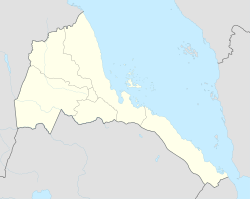Debarwa
| Debarwa | ||
|---|---|---|
|
|
||
| Coordinates | 15 ° 6 ′ N , 38 ° 50 ′ E | |
| Basic data | ||
| Country | Eritrea | |
| Debub | ||
| ISO 3166-2 | ER-YOU | |
| Residents | 25,000 | |
Debarwa ( Tigrinya ድባርዋ Dəbarwa , also Dəbarowa , Dbarwa , Arabic دباروا) Is a city in the region Debub in Eritrea with about 25,000 inhabitants.
The city is located about 30 km south of the Eritrean capital Asmara on the Mareb River . Due to the proximity to Asmara, the infrastructure is well developed for Eritrean conditions.
Debarwa is on the traditional trade route from Massaua on the Red Sea inland and was the seat of the Baher Negash . Francisco Álvares described Debarwa in the 16th century as the seat of the most important residences of the Baher Negash and as a city that was "very good" and "situated on a very high rock". According to Álvares, the “King's Houses” were on the rock above the Mareb River, laid out like a fortress and guarded by more than 300 mounted men. They were visited daily by numerous people who came for business reasons or to deliver petitions. Their “presence attracted numerous women”, also because “the men are wealthy and like courtiers”. The place consisted of "300 houses or more" and on Thursdays there was a large market for which another "300 or 400 people" gathered in Debarwa. The place had two adjacent churches, one for the men and one for the women.
history
In 1535, Debarwa was taken by Ahmad ibn Ibrahim al-Ghazi . After its fall in 1543, Debarwa became the seat of the Baher Negash again, but then fell to the Ottoman Turks, who had occupied Massaua in 1557. The Ottoman commander Özdemir Pascha had a fort built in Debarwa, "with a long wall and a very high tower", in which gold and silver objects, precious stones and expensive imported clothing were allegedly stored. The attempt to expand the Ottoman power from there to the surrounding area failed, however, and the well-armed population at the time stormed the fort, so that the Ottomans had to withdraw temporarily. In the period that followed, there were many fights in Debarwa and the surrounding area between the Ottomans - supported by the Baher Negash Yeshaq - and the Ethiopian emperors Minas and Sarsa Dengel . Sarsa Dengel took the fort in 1576 and had it destroyed.
Despite these struggles between three sides, Debarwa retained its political and economic position for the next two centuries. The French traveler Charles Jacques Poncet reported in 1699 that all goods imported into Ethiopia from the Red Sea came through Debarwa. A century later, Scottish explorer James Bruce described Debarwa as a "common passage" between Massaua and Tigray . According to an Armenian trader, the city then paid the emperor 500 ounces of gold a year. At the beginning of the 19th century Debarwa was already in decline, because the ruler of Tigray Mikael Sehul had usurped the power of the Baher Negash, and Debarwa lost importance in trade compared to Adwa . The British traveler James Theodore Bent described Debarwa in the late 19th century as "a few piles of stones, an almost ruined church and a few pathetic huts".
Individual evidence
- ↑ a b c d Richard Pankhurst: Dəbarwa , in: Siegbert Uhlig (Ed.): Encyclopaedia Aethiopica , Volume 2, 2005, ISBN 978-3447052382
